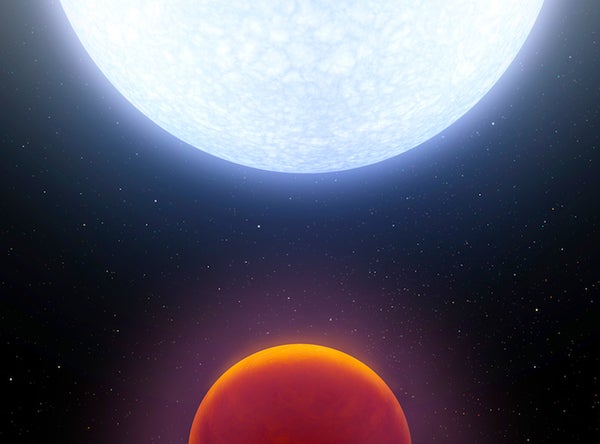This article was published in Scientific American’s former blog network and reflects the views of the author, not necessarily those of Scientific American
Perhaps the biggest lesson we've had from the exoplanetary discoveries of the past quarter century is to always expect the unexpected. Not in the Monty Python sense, but in the scientific sense.
Take for example the seemingly innocuous fact that in our solar system the planets all orbit in the same sense as the Sun itself rotates, and for the most part in a rather flat set of orbital planes. Specifically, the orbital inclinations of planets (the angle the orbital planes make relative to a datum) are fairly small. We often use the Earth's orbital plane as the reference, but we can also use the Sun's equator, and find that all the major planets lie within about 7 degrees of that plane (the Earth actually being the most deviant, at about 7.2 degrees inclination).
This architectural feature has helped guide our thinking on how planets and stars form. In fact the basic idea of worlds condensing out of a spinning, disk-like nebula - all moving in the same sense and in a similar plane - goes back to Immanuel Kant and Pierre-Simon Laplace in the 1700s (with help from others).
On supporting science journalism
If you're enjoying this article, consider supporting our award-winning journalism by subscribing. By purchasing a subscription you are helping to ensure the future of impactful stories about the discoveries and ideas shaping our world today.
The hitch is that we've discovered that this kind configuration is not fully universal.
In particular, many of the most extreme exoplanets don't follow these rules at all. Gas giant worlds in shockingly tight orbits around their parent stars - the so-called hot Jupiters - are quite often seriously misaligned with the seemingly 'natural' equatorial plane of their systems. Some are so misaligned that their orbits look like they've 'flipped' - with the planets whizzing around the star in the opposite sense to the stellar rotation.
Now a hot Jupiter has been discovered with what appears to be the best constrained polar orbit thus far. This world, called WASP-189b, orbits a hot star about 320 light years from us. The orbit is super-short, taking about 2.7 days to zip around, placing the planet at a distance of only 4.5 times the radius of the star itself.
This proximity heats the planet - estimated to be about two times the mass of Jupiter - to a toasty 2,600 Kelvin or more. Making it an 'ultra-hot-Jupiter'.
But the really impressive thing about this system is its polar orbit; WASP-189b seems to have an orbital inclination very close to 90 degrees (even more polar than previous examples). Measuring that inclination is not easy, and the researchers deploy a technique that exploits the Rossiter-McLaughlin effect - where an object sequentially blocks the varyingly Doppler-shifted light from a rotating body, and by measuring the light's spectrum we can deduce the path the object takes, and therefore its orbital inclination.
Like with other mis-aligned hot-Jupiter worlds, the big question is how does this situation arise? We don't know for sure. One idea is that these planets have to form at larger distances from their stars and then migrate inwards - due to interactions either with a proto-planetary disk or other worlds, or both. Those interactions can also pump up the ellipticity of the orbit and its inclination. Later on the tidal forces between the planet and the star can pull it in close, but preserve a high orbital inclination...maybe.
One thing is clear, the universe is filled with phenomena that more than happy to expose our ignorance, and that is a truly wonderful thing.
